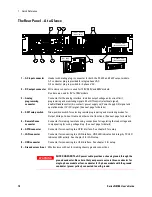
Installation
2
Series N8700 User’s Guide
25
Connecting the Load
WARNING
SHOCK HAZARD
Turn off AC power before making rear panel connections.
Wires and straps must be properly connected and screws securely tightened.
The following factors should be considered when selecting wiring to
connect the load to the power supply:
Current carrying capacity of the wire
Insulation rating of the wire should be at least equivalent to
the maximum output voltage of the power supply
Load wire voltage drop
Noise and impedance effects of the load wiring
Wire Size
WARNING
FIRE HAZARD
To satisfy safety requirements, load wires must be large
enough not to overheat when carrying the maximum short-circuit current of
the power supply. If there is more than one load, then any pair of load wires
must be capable of safely carrying the full-rated current of the supply.
Paralleled load wires may be required for larger-ampacity power supplies.
The following table lists the characteristics of AWG (American Wire
Gauge) copper wire.
AWG
equivalent
area in mm
2
nearest Metric
wire size
Ampacity
Note 1
Resistance
(
Ω
/1000 feet)
Note 2
18
0.823
1.0 mm
2
14
6.385
16
1.31
1.5 mm
2
18
4.016
14
2.08
2.5 mm
2
25
2.526
12
3.31
4 mm
2
30
1.589
10
5.26
6 mm
2
40
0.9994
8
8.37
10 mm
2
60
0.6285
6
13.30
16 mm
2
80
0.3953
4
21.15
25 mm
2
105
0.2486
2
33.62
35 mm
2
140
0.1564
1/0
53.48
70 mm
2
195
0.0983
2/0
67.43
70 mm
2
225
0.0779
3/0
84.95
95 mm
2
260
0.0618
Note 1. Ampacity is based on 30 °C ambient temperature with the conductor rated at
60 °C. For ambient temeratures other than 30 °C, multiply the above
ampacities by the following constants:
Temp (°C)
Constant
Temp (°C)
Constant
21-25 1.08
31-35 0.91
26-30 1.00
36-40 0.82
Note 2. Resistance is nominal at 20 °C wire temperature.
















































